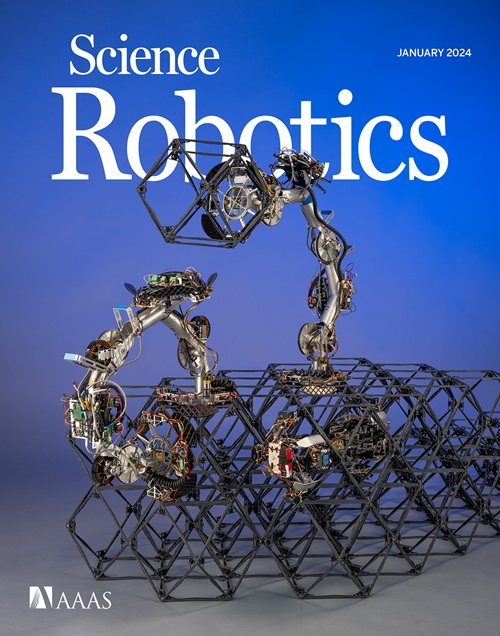A springtail-inspired multimodal walking-jumping microrobot
IF 27.5
1区 计算机科学
Q1 ROBOTICS
引用次数: 0
Abstract
Although legged robots have demonstrated effective mobility in some natural settings, as robot size decreases, obstacles in their environment become challenging to overcome. Small arthropods scale obstacles many times their size through jumps powered by mechanisms that overcome speed and power limitations of muscle alone. The motivation for this study was to explore the marriage of impulsive (jumping) and nonimpulsive (cyclic legged ambulation) behaviors in a centimeter-scale robot. Here, jumping is achieved by striking the ground with a bioinspired appendage connected to a parallel linkage. As the linkage configuration passes through the singularity, a torque reversal occurs whereby elastic energy slowly stored by force-dense velocity-limited shape memory alloy actuators is rapidly released. A passively driven elastic hinge is introduced in the striking arm to mediate ground contact forces and direct jumping. High-speed video recording of the 14-millisecond launch phase reveals previously undocumented takeoff dynamics closely resembling those of springtails. A dynamic model was derived, and an experimentally validated simulation was used to optimize the design of key components. The 2.2-gram, 6.1-centimeter-long mechanism achieved a maximum horizontal jumping distance of 1.4 meters (23 body lengths), surpassing that of similarly sized insects. The mechanism was integrated with an agile quadrupedal microrobot with leg articulation suitable to achieve the ideal jumping posture. The platform demonstrated repeatable directional takeoffs and upright landings, enabling complex maneuvers to overcome obstacles and gaps. Last, we used this bioinspired robot to offer reflection on hypotheses related to springtail jumping behavior.一个受弹尾启发的多模态行走跳跃微型机器人
尽管有腿机器人已经在一些自然环境中表现出了有效的机动性,但随着机器人尺寸的减小,它们所处环境中的障碍变得难以克服。小型节肢动物通过跳跃来跨越比自己大许多倍的障碍物,这种跳跃机制克服了肌肉本身的速度和力量限制。本研究的动机是探索厘米级机器人的冲动(跳跃)和非冲动(循环腿行走)行为的结合。在这里,跳跃是通过与平行连杆相连的仿生附属物撞击地面来实现的。当连杆结构通过奇异点时,发生转矩反转,由力密集限速形状记忆合金作动器缓慢储存的弹性能迅速释放。在击打臂中引入被动驱动弹性铰链,以调节地面接触力和直接跳跃。高速视频记录了14毫秒的发射阶段,揭示了以前没有记录的起飞动力学,与弹尾非常相似。建立了动力学模型,并采用实验验证的仿真方法对关键部件进行了优化设计。这种2.2克,6.1厘米长的机制实现了1.4米(23个身体长度)的最大水平跳跃距离,超过了类似大小的昆虫。该机构与一个灵活的四足微型机器人集成,该机器人具有合适的腿部关节以实现理想的跳跃姿态。该平台演示了可重复的定向起飞和垂直着陆,使复杂的机动能够克服障碍和间隙。最后,我们利用这个仿生机器人对与弹尾跳跃行为相关的假设进行了反思。
本文章由计算机程序翻译,如有差异,请以英文原文为准。
求助全文
约1分钟内获得全文
求助全文
来源期刊

Science Robotics
Mathematics-Control and Optimization
CiteScore
30.60
自引率
2.80%
发文量
83
期刊介绍:
Science Robotics publishes original, peer-reviewed, science- or engineering-based research articles that advance the field of robotics. The journal also features editor-commissioned Reviews. An international team of academic editors holds Science Robotics articles to the same high-quality standard that is the hallmark of the Science family of journals.
Sub-topics include: actuators, advanced materials, artificial Intelligence, autonomous vehicles, bio-inspired design, exoskeletons, fabrication, field robotics, human-robot interaction, humanoids, industrial robotics, kinematics, machine learning, material science, medical technology, motion planning and control, micro- and nano-robotics, multi-robot control, sensors, service robotics, social and ethical issues, soft robotics, and space, planetary and undersea exploration.
 求助内容:
求助内容: 应助结果提醒方式:
应助结果提醒方式:


